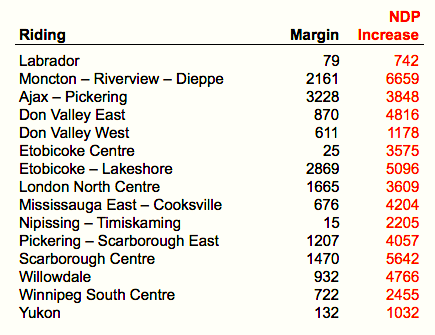Pundits’ Guide responds – corrected
In our ongoing tussle over the nature of vote-splitting and whether it can be said to account for the Harper majority (earlier installment here and on Twitter), Alice Funke of Pundits' Guide has kindly supplied the requested table of ridings where incumbent Liberals lost to the Conservative Party of Canada, and where the margin of victory was smaller than the increase in the NDP vote. [Contrarian reader Joey Schwartz noticed an error in the first version of this chart, which Funke has NOW corrected. My thanks to both.]
In all, 15 seats meet my criteria, enough (if one accepts some assumptions Funke rejects) to reduce the Harper seat tally to a 151-seat minority.
Alice and I differ as to whether this is a valid rough-and-ready measure of seats where vote-splitting by progressives cost Liberal seats. She points out that in one of these seats, Yukon, the Greens placed third, and their vote rose more than the NDP. In nine six others, the CPC vote rose more than the NDP. The Liberals had already lost one seat, Vaughan, in a byelection, and voter turnout increased across the board.
I acknowledge the likelihood that a lot of Liberals and 2008 non-voters swung to the CPC in 2011; my argument is that enough Liberals swung to the NDP in these ridings to facilitate a Harper majority. As with all counterfactual arguments, it's a matter for debate. Funke responds (after the jump):
[Contrarian reader Joey Schwartz noticed an error in the first version of this chart, which Funke has NOW corrected. My thanks to both.]
In all, 15 seats meet my criteria, enough (if one accepts some assumptions Funke rejects) to reduce the Harper seat tally to a 151-seat minority.
Alice and I differ as to whether this is a valid rough-and-ready measure of seats where vote-splitting by progressives cost Liberal seats. She points out that in one of these seats, Yukon, the Greens placed third, and their vote rose more than the NDP. In nine six others, the CPC vote rose more than the NDP. The Liberals had already lost one seat, Vaughan, in a byelection, and voter turnout increased across the board.
I acknowledge the likelihood that a lot of Liberals and 2008 non-voters swung to the CPC in 2011; my argument is that enough Liberals swung to the NDP in these ridings to facilitate a Harper majority. As with all counterfactual arguments, it's a matter for debate. Funke responds (after the jump):
16 May, 2011
